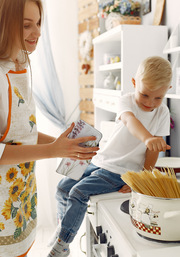How To Help Your Child Safely Use Pinterest
Social media sites are a blessing and a curse. They allow people of all ages to connect with one another, but they can also leave children vulnerable to unsafe information. Pinterest is a social media site that is trying to make itself safe for children. If your child wants to use this site to find inspiration, they can.
However, the site hasn’t perfected its safety features yet. As a caregiver, you should know how to help your child safely use Pinterest.
Use Pinterest’s Safety Features
As mentioned, Pinterest tries to make itself safe for children. The minimum age requirement to use Pinterest in the US is 13, although, in some countries, it’s based on the age of consent. Any accounts for someone between the age of 13 and 16 are automatically private. This means no one can see your child’s pins or boards, although anyone can see comments your child leaves on a pin. Accounts become public when the user is 16, but no one can message an account for someone under the age of 18.
Set Up Browser Parental Controls
While Pinterest’s safety features can help protect your child’s privacy, they don’t protect your child from what they could see on the app. Like all social media accounts, Pinterest contains mature content about subjects like physical intimacy and eating habits. The site does not allow people to tag this content with inappropriate words or phrases, but that doesn’t prevent people from uploading this type of content.
Even if the content doesn’t look mature on Pinterest, many pins can lead your child to other sites. Some of these sites are safe, and others are not. The best way to prevent your child from accidentally seeing mature content or ending up on a mature site is with browser parental controls. You can try some of the best rated apps for parental controls that will filter or block bad websites.
Follow Their Pinterest Account
Following your child’s Pinterest account doesn’t allow you to see everything they see. However, you can monitor what they pin. Beware that Pinterest allows for private boards that only the account holder can see. You may need to periodically check your child’s account from their login if you’re concerned they may try to use this feature.
Prompt Honest Discussions
Teens may feel that you’re trying to control them if you want to look at their Pinterest through their login. This is a good opportunity to start an honest conversation about internet safety and potentially mature content. Your child should know what information is and isn’t appropriate online and feel safe coming to you if they see something wrong.
You don’t want every honest discussion to feel like a giant warning sign though. Prompt honest discussions about other subject matter your child is seeing, such as recipes they may want to try. You can use these recipes to make cooking a fun family bonding activity and encourage a positive relationship with Pinterest.
You can help your child safely use Pinterest through Pinterest’s safety features and third-party monitors. However, no safety features or browser monitors can replace your connection with your child. Talking with them about internet safety before they get on social media and while they use it is the best way to protect them.




